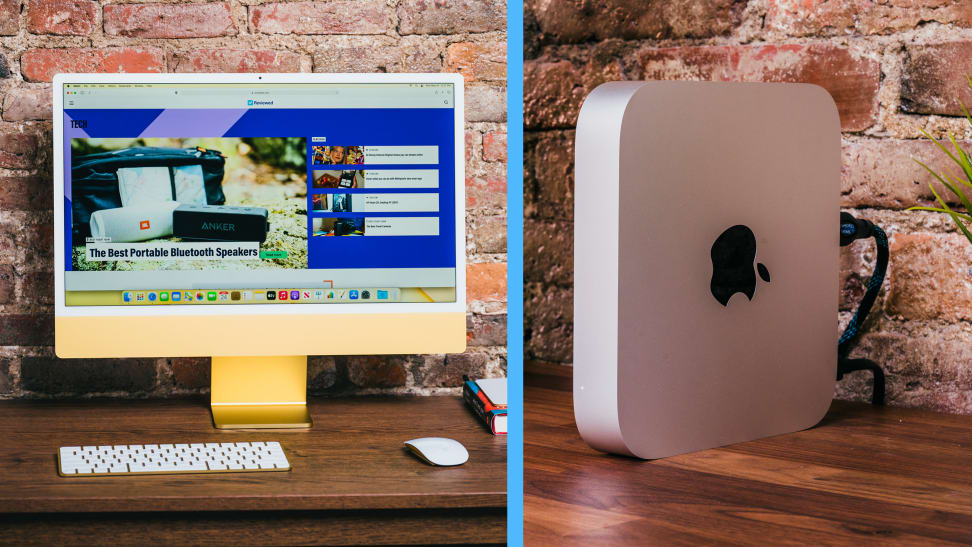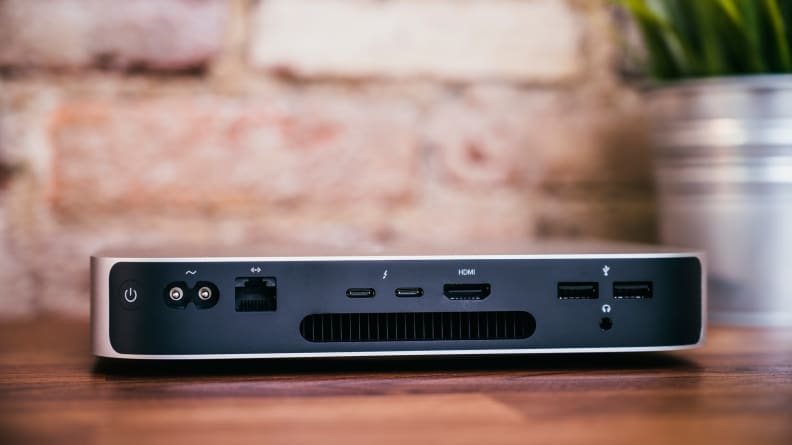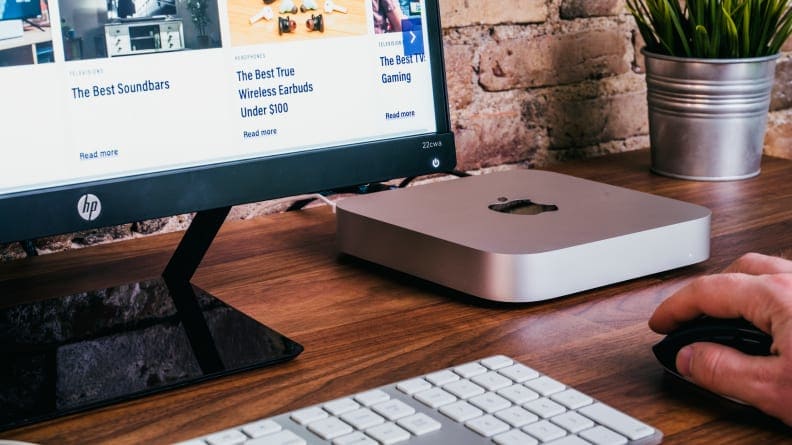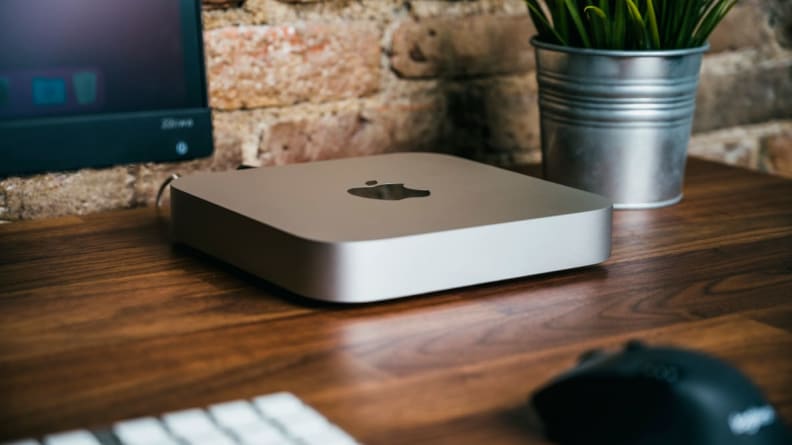Mac Mini vs iMac 24-inch: Which one is right for you?
We break down the differences between Apple's latest desktops.
 Credit:
Reviewed / Jackson Ruckar
Credit:
Reviewed / Jackson Ruckar
Products are chosen independently by our editors. Purchases made through our links may earn us a commission.
Apple’s M1 Mac Mini and the 24-inch iMac both run on the M1 processor, which means the choice between the two largely boils down to price and features. Do you need (or desperately want) an amazing display with a great sound system wrapped up in an easy-to-use package? Or do you just want a basic box that’s powerful enough to run all your favorite applications? We break down the 24-inch iMac with the M1 chip and the M1 Mac Mini so you can make the decision that perfectly suits your needs. Buy the Mac Mini for $659 from Amazon
Buy the 24-inch iMac for $1,294 from Amazon
Performance and Speed

Both the 24-inch iMac and the Mac Mini run on Apple's M1 processor, an ultra-efficient chip adapted from their MacBook lineup.
At their core, both the M1 Mac Mini and the M1 iMac have the same computing power. Both run on Apple’s M1 processor, which handily outperforms most laptops running on midrange Intel or AMD processors. If you need a desktop PC for heavy productivity and light 3D applications, such as Adobe Creative Cloud software, you shouldn’t have a problem with either of the Mac desktops. That said, there are some differences in performance. The base 24-inch iMac has one fewer graphics processing core than the Mac Mini linked above (7 cores versus 8 cores). In real-world applications, this missing core hardly makes a difference—the 8-core GPU averages about 3 more frames per second in World of Warcraft on medium settings, for instance—but it could affect your workflow if you use your computer for a lot of graphics-heavy applications.
The Mac Mini and iMac also work slightly differently when it comes to cooling, but they are both more than sufficient for the ultra-efficient processor. The Mac Mini has a single fan in a spacious chassis that gives the processor plenty of breathing room. Meanwhile, the iMac’s fans must push the air away from the processor in an ultra-thin profile. In both cases, the M1 processor is so efficient that the fans almost always stay silent. Our pick: Draw
Ports and Features

The Mac Mini has a multitude of ports for your needs.
Both the iMac and Mac Mini have support for Bluetooth 5.0 and Wi-Fi 6. This allows for a fast, wireless connection to your local network and any needed peripherals without an issue. Because they use the same processor, they also share the same screen support. Each computer can run one 6K resolution display at 60Hz and one 4K display at 60Hz simultaneously. From there, things begin to diverge a bit, starting with the ports selection. If you are considering a desktop over a laptop, chances are you care about your PC’s port selection. The Mac Mini, despite its palm-size body, has a decent selection of ports, including two Thunderbolt 3 / USB 4 ports, two USB-A 3.1 Gen 2 ports, an HDMI 2.0 port, a 3.5mm headphone jack, and a gigabit Ethernet port. Meanwhile, the base 24-inch iMac only comes with 2 Thunderbolt 3/USB 4 ports and a headphone jack, but the pricier $1,499 model adds an Ethernet port and two more Thunderbolt / USB 3 ports. However, the Mac Mini’s advantage diminishes when you factor in features and accessories. The Mac Mini is just that: a little PC that's smaller than a laptop, barely registers on your desk, and can easily be tossed in a backpack.

The Magic Mouse and Keyboard are excellent peripherals that bring useful features such as swiping and Touch ID to desktop computers.
The all-in-one 24-inch iMac is a PC, a computer monitor, and a speaker system. Additionally, it comes bundled with Apple's excellent Magic Keyboard, Magic Mouse, and Magic Trackpad, which all offer an all-aluminum build that matches your iMac’s color scheme and come pre-paired with the iMac for flawless wireless performance. The $1,499 model's keyboard also comes with Touch ID. The iMac also comes with a 1080p webcam included, which is handy for video calls and streams. The Mac Mini does not have any webcam at all. The iMac pulls far ahead of the Mac Mini with its phenomenal display and sound system. The Mac Mini has no display, and its speaker is tinny and thin. Meanwhile, the iMac’s 4.5K Retina display is incredibly bright, has a wide color gamut, and is ideal for film enthusiasts and visual designers alike. A screen of similar quality can cost hundreds of dollars, so pairing said screen with a Mac Mini would already approach the cost of the iMac itself. Meanwhile, the iMac’s bottom lip houses multiple speakers that give a rich, detailed sound that’s excellent for listening to movies or music.
Our pick: iMac 24-inch
Price

The Mac Mini is an affordable desktop PC with a small footprint.
For its raw computing power, the Mac Mini is a fantastic deal. The Mac Mini starts at $659, but can be found on sale for as low as $600. It is almost half the price of the iMac, but in return you will have to provide your own monitor, keyboard, mouse, and if you do any regular listening, speakers. Buying the Mac Mini and peripherals that match the quality of the iMac’s included accessories (an HDR10-certified 4K display and a premium wireless keyboard/mouse bundle) can rack up enough costs to match the iMac’s asking price. Starting at $1,294, the iMac will set you back about as much as a MacBook Pro 13. However, the extra money also comes with the convenience of an all-in-one desktop: a premium keyboard, mouse, and trackpad; a loud sound system; and a 4.5K display with excellent color gamut. Additionally, setting up an iMac out of the box takes five minutes, and the computer is so beautiful as to function as a decorative piece in your living space. However, the base model’s limited port selection and handicapped graphics processor make the $1,499 model worth it if you can spare the cash.
Our pick: Mac Mini
And the winner is…

The Mac Mini leaves a minimal footprint on any desk.
Because the Mac Mini is the perfect Mac for a cost-effective home computer, it’s the best choice for most people. For $659, you get a hand-sized PC with the same Apple Silicon M1 chip as the pricier $1,294 24-inch iMac. However, the iMac packs a lot of value for stringent sound and display enthusiasts. It’s an all-in-one solution whose 4.5K resolution retina screen and premium peripherals make for a fantastic family PC for both productivity and entertainment. The base iMac costs $1,299, but the $1,499 model comes with extra ports, an Ethernet connection, and one more graphics processing core for a slightly faster graphics processor. If you need a fast productivity PC and a reliable display for visual work, the iMac is also an excellent choice. Buy the Mac Mini for $699 from Amazon
Buy the 24-inch iMac for $1,299 from Amazon
The product experts at Reviewed have all your shopping needs covered. Follow Reviewed on Facebook, Twitter, Instagram, TikTok, or Flipboard for the latest deals, product reviews, and more. Prices were accurate at the time this article was published but may change over time.
